Helms Alee is a 3 piece band from Seattle, WA. For those of you not familiar with Helms Alee – they formed in 2007 and consists of Dana James on bass, Hozoji Marguillis on drums and Ben Verellen on guitar. The music is a hard to describe, and is why I love this band. A lot of times when you see a band play live, you see a couple of songs and you “get the jist” and have them pretty figured out. With Helms Alee, they constantly adjust what is happening, which for me, makes it very interesting live. One example, all members will take the lead on vocals. The music itself goes between heavy, riffy, but then will get very spacey and weird. This is a 3 piece.. and as 3 pieces go, it gets insanely sonic.
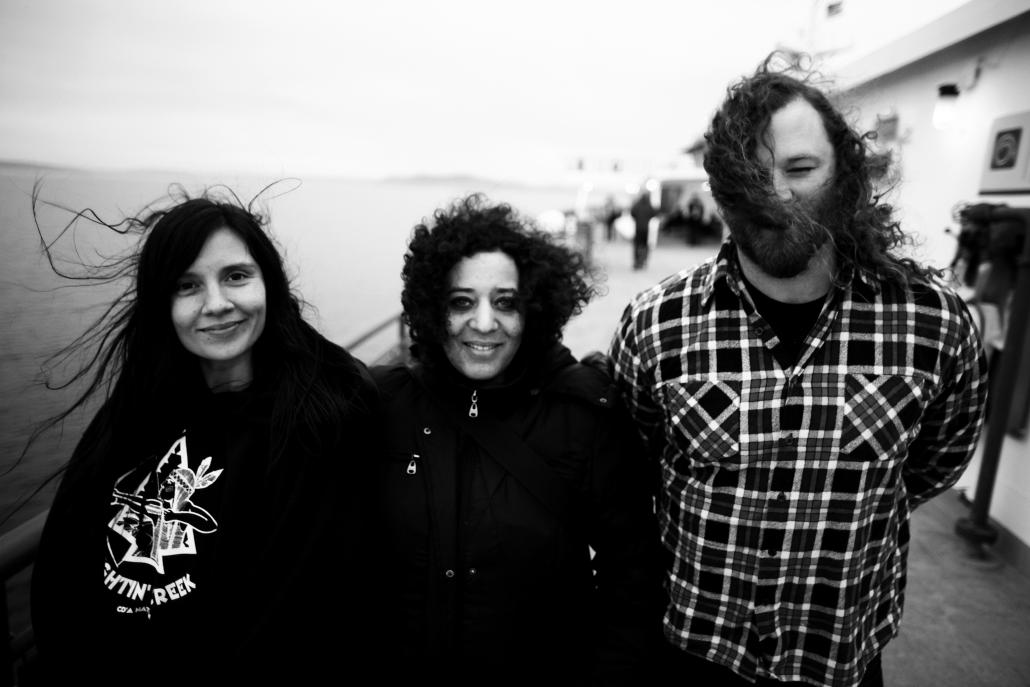 Check out this full performance on KEXP from a couple of years ago..
Check out this full performance on KEXP from a couple of years ago..
Ben Verellen sings and plays guitar in Helms Alee, but the dude is heavily involved in other projects (plays drums in The Constant Lovers), but how I first started to know Ben is with his kick-ass amp company – Verellen Amps. Verellen Amps are making some of the best amps on the planet with a focus on power and sweet tone. I’ve been wanting to talk to Ben about amps and pedal development for years, and recently Helms Alee played a show in Missoula, MT and we had a chance to catch up.
Below is our conversation where we talked about pedals, amps and their upcoming tours with The Melvins and Russian Circles!
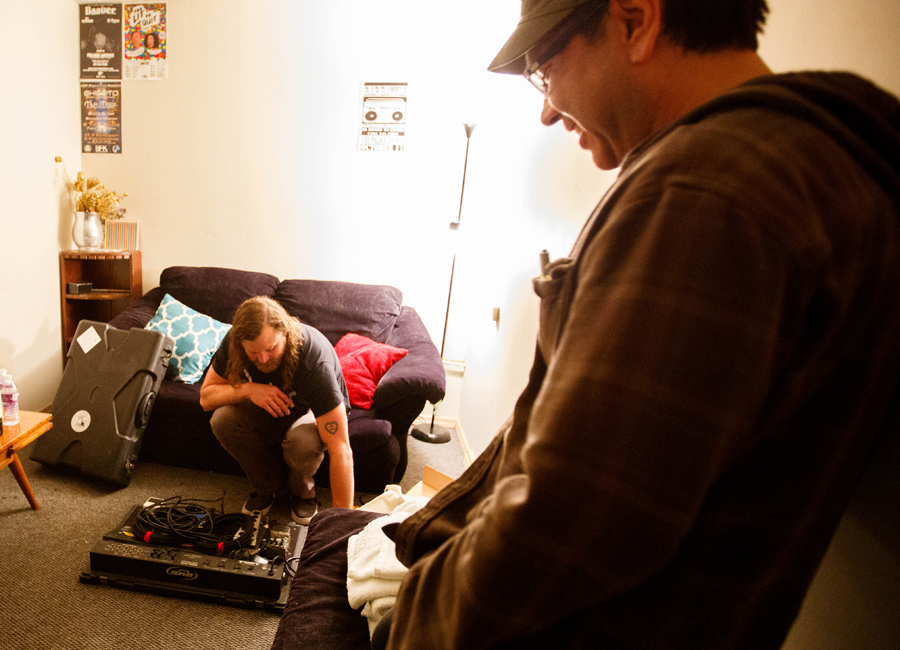 EB: Let’s talk about some pedals. Looking like you have a Fulldrive
EB: Let’s talk about some pedals. Looking like you have a Fulldrive
BV: It’s a Fulldrive II, but not the Mosfet one.
EB: How would you describe the key tones for Helms Alee?
BV: Basically, my thing is I have two loud clean tube amps that have an open pallet and headroom. Not a lot of colorization – just a little bit of that tubey thing.
EB: Which amps are those?
BV: They’re custom oddballs that I made for myself. They’re just loud and clean and have a little bit of EQ. One of them has reverb that I never use. Basically, they’re just to be loud, clean and uncolored as far as a tube amp would go. The preamps don’t overdrive at all. I like to push them to the brink where they saturate and compress but don’t distort.
When I have that Fulldrive and thats sort of like the cleaner of the two sounds. It’s an over driven sound. The Fulldrive makes that box-y, mid-range-y, tube screamer-y tone. It sounds like an over driven guitar amp – what you’d expect a guitar amp to sound like. But these amps I’m putting it through are capable of lot more bass and treble. There is this brighter frequency spectrum, a little more on the hi-fi end of things. So you can have it running through that pedal and get that guitar vibe, but then I have this fuzz pedal after. When I step on the fuzz pedal it opens up the low end and treble.
EB: What fuzz pedal is that?
BV: It’s a bizarre one. Bruno is the name of the company. It’s a Japanese company from the 60s. It’s called a Bruno Fuzz Wau
EB: So it’s the wah I see. Do you use that solely as a fuzz or do you use the wah portion as well?
BV: Typically, but every once and a while – there actually is a new song that uses a little bit of the wah in it. But usually, I just use the fuzz. It’s one of the many derivatives of the Univox superfuzz, but it has some things about it that make it unique. And some things have been done to it to make it a little bit more unique.
EB: So the fuzz is only on for parts, but is the Fulltone on all the time?
BV: Typically. There are only a couple of moments where it will be completely clean. So the Fulltone will be on and that will be like guitar sound, but then the fuzz turns on and it will be something larger.
EB: Looks like beyond that we have the Line 6 Echo Park Delay and the Boomerang
BV: The Line 6 has a rotary selector that has a bunch of modes and one of them has a rhythmic pattern. It’s something I set up 12 years ago and never mess with it.
EB: Same thing as the Fulldrive? Is it always on or for parts only?
BV: I usually have that on for tight clean and spacey stuff.
EB: Are using the Boomerang for live looping on rhythmic portions or segue between songs, etc?
BV: It’s kind of been worked into the stuff where in the midst of the song where you can do some looping like a pad and you can bring the pad in and out. I bought the Boomerang while I was in high school. I saw a band called Enemymine. Mike from godheadSilo, do you remember that band?
EB: Oh yeah!
BV: And when he did Enemymine I saw them and he was playing through one doing some cool shit and I got all inspired. “I’m going to rip that dude off and get one of those and see what I can do!â€
EB: Let’s talk about the Jazzmaster you’re playing.
BV: That is a 1999 American Fender Jazzmaster and my buddy Casey who played in a band called Harkonen with me growing up, he bought that. He used it for a bunch of years and he ended up selling it to me for a couple of hundred bucks when he moved away from town. So I’ve had it since 2002 or 2003.
EB: What’s appealing about Jazzmasters?
BV: I totally just stumbled into it really. All the pedals, all the amps have been designed around that sound. So it is what it is. But it’s cool, it’s got a really high top to it that is really cool, it’s not as mid-range focused as SGs or something like that. It has a really sparkly kind of chime to it that is really cool. I like playing behind the bridge and all that stuff. You can bend it, but I don’t use the whammy, but I like pushing on the bridge.
EB: You’re currently on tour right now, but I see you have a tour coming up with The Melvins and Russian Circles coming up. How do you manage Verellen Amps and be able to go on the road?
BV: That is right on the edge of my mind too! There has been a guy that has been training over the last year for this moment to happen. He’s been helping with the wiring of the amps and eventually will be taking over the production including ordering, building and all the shipping. My job then becomes dealing with customers, designing the amps when the jobs come in and working out the notes.
EB: How did you manage being on tour before?
BV: Helms Alee hasn’t done a lot of tours in the past and now it’s the perfect opportunity to force me to make it all work.
EB: How did you get the whole Melvins / Russian Circle gigs?
BV:  Circles, we’ve been buddies with for years and years and toured with them a handful of times. They have a record coming out this Fall, we have a record coming out this Fall, so we’ve been talking about it for months. They just said, “we’re doing this tour – your welcome to comeâ€. The Melvins thing was that they were taking submissions, so we threw our hat in the ring and they said “yeahâ€. Pretty crazy because me and Hozi specifically went “you’re into that music?†“I’m into that music tooâ€. That was one of the bands we definitely bonded over. It was one of the common tongue where we both understood. That was one of the bands we both get – an anchor of understanding.
EB: It’s a lot of dates right?
BV: 6 weeks
EB: And the tour with Russian Circles is like 6 weeks as well?
BV: No, that one for us at least, is shorter. We’re only doing the East Coast part of that trip. They would have already done the West Coast. I think we’re doing 3 weeks with Circles.
EB: I know that Mike Sullivan plays Verellen Amps, what about Brian Cook?
BV: Yeah, Brian has a Meat Smoke and he has a Ampeg Solidstate that he uses for his Taurus / Moog stuff.
EB: What band or artist that uses your amps blows your mind that they’re using a Verellen?
BV: There’s a few. I think Blonde Redhead is a pretty wild one. Especially since the guy plays a Skyhammer which was designed to be a high gain shredder amp, and he uses the clean channel. Basically what happened, his Hiwatt had to be re-tubed in Seattle, so the woman who does sound called me and asked “Can you come help during their sound check?†I said “Sure†and I had a Skyhammer right there, so I thought I would just bring it – on a whim. I came in and said “here, if you want, you can use this for your soundcheck. I’ll take your amp down and re-tube it and bias it up and bring it back.†I was downstairs biasing it up, and at some point he came downstairs and said “.. hey, can I buy that?†I said, “that’s kind of a heavy metal amp†and he said, “no, no.. it’s perfect!†It does have some Hiwatt elements to it, so I’m not totally surprised. Anyway, that blew me away!
EB: So how did you get into the whole electronics gig?
BV: I went to college for electrical engineering. So I studied for 8 years to get into something involved with music electronics. I was interested in gear and how it works. I wasn’t so fixated on tubes to begin with, but eventually it occurred to me that could be sort of low barrier entry, because it’s a super robust and simplistic technology to get into. Some of these amps have a dozen parts in them. They’re easy to get in and start making things happen. If you do something with an elaborate solidstate circuit you have to design this whole thing on CAD and get the PCB design, send out for that and get the whole thing together, populate it, stick it together and see if it works. If it doesn’t you have to go back. With a tube amp, it’s a little bit more like “let me work, let’s move that here, let’s change that value†and you can just pick things up and do it.
EB: So you do this all on a turret board?
BV: Yeah, that’s right. Sometimes it’s a combination of turret board and sometimes there will be a PCB for dedicated filter caps for a power supply, etc. Things that don’t have a whole lot to do with tone, but want them to live comfortably. And there are some point-to-point stuff, little stand-offs with leads to jacks to pots to tube sockets.
EB: Let’s talk about the pedals – the preamp and the fuzz.
BV: The fuzz has been discontinued for the time being while I’m doing a little bit of a redesign.
EB: What’s the story on the preamp?
BV: There are a couple of preamps and we do custom ones as well. The Meat Smoke is one of the bass amps / pseudo guitar amp that we do. You can have this pedal that has everything that’s on the front end of that amp and it’s got the full two channels and separate EQ for each channel and you can run that into any power amp input of effects loop return or any power amp you can get your hands on and have at least half of the equation. So that was one possible use for that. Another one is you can run out the record output direct in to record. There was a guy who did a band called Lombar that Southern Lord put out and all the guitars were recorded through the Skyhammer version of that preamp. The Skyhammer circuit is more like a modern high gain shredder.
EB: So the preamps are loaded with preamp tubes, etc?
BV: Yeah, big power transformer, tubes running at full voltage – exactly how they would if they were running in an amp. It’s kind of a weird thing. You have to get people to understand the difference. “It’s a pedal – why is this pedal $700?†Well, actually, if it was in a rack enclosure it would make sense to you. It’s the full blown preamp. So you can use it on the front end if you wanted. You can put it into a clean amp. You can have the dual colorization of that preamp and whatever you’re plugging in to. Yeah, lots of different ways you can use that thing. Basically, I wanted to do something that was more affordable than the full blown amp. But I didn’t want to do something “cheaper†so let’s just do something that was half of the picture
Here is the break down of Ben Verellen’s pedalboard:
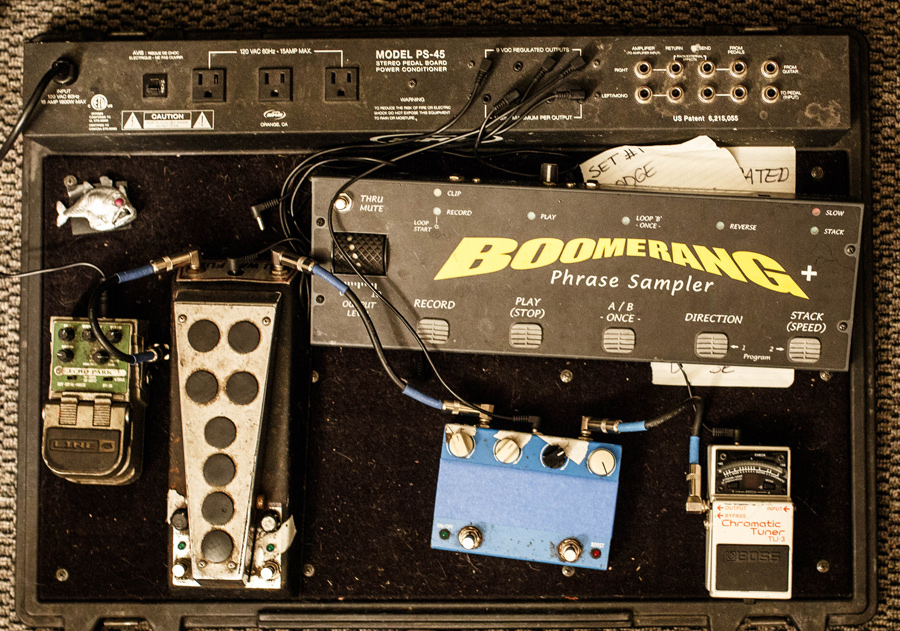 Boss TU-3 Tuner
Boss TU-3 Tuner
Fulltone Fulldrive 2 (non-mosfet version)
Bruno Fuzz Wau
Line 6 Echo Park Delay
Boomerang Phrase Sampler (version 1)
Here are some photos taken at the Palace Lounge in Missoula, Montana. Photos generously provided by Amy Donovan Photography
[huge_it_gallery id=”3″]Let me know what you think by commenting below!

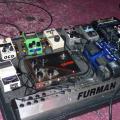
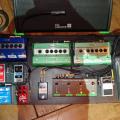

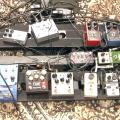
Leave a Reply